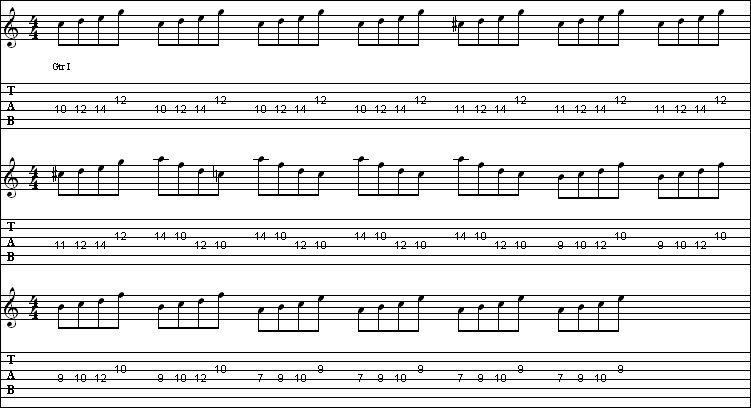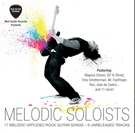10 Guitar Speed Training Exercises That No Guitar Player Should Be Without!
 Tennyson is author of The Essential Guide to Guitar Virtuosity, which is an excellent ebook we recommend and can be downloaded from guitarspeedsecret.com. He’s just sent us this massive free lesson on speed training, if you like this lesson make sure you visit his site!
Tennyson is author of The Essential Guide to Guitar Virtuosity, which is an excellent ebook we recommend and can be downloaded from guitarspeedsecret.com. He’s just sent us this massive free lesson on speed training, if you like this lesson make sure you visit his site!
Speed Exercise no. 1
One of the best exercises for obtaining a clean style, is to use the chromatic scale as a training tool. What I like about this scale is the fact that you can customize it. In actual fact, any exercise, scale or mode that you practice with, can be customized in many, many ways.
The best advice that I can give to any guitarist who is serious about becoming efficient with their picking, is to think of ways that you can trick your fingers. More specifically, find ways that you can invert a pattern.
By inverting patterns and reconstructing them, we can accomplish three things.
1. It opens up our mind and new possibilities make themselves visually present on the fret board.
2. Your fretting hand is constantly being renewed and challenged.
3. Your picking hand is consistently being presented with
changes in the picking motions.
e|—————————-
b|—————————-
g|—————————-
d|——————-1-2-3-4–
a|———-1-2-3-4———–
e|-1-2-3-4——————–
——————-1-2-3-4–|
———-1-2-3-4———–|
-1-2-3-4——————–|
—————————-|
—————————-|
—————————-|
Its very simple. First finger, second finger, third finger and forth. Using alternate picking (down, up), practice it going up and then coming back down.
Speed Exercise no. 2
This one is a small alteration, but believe me, the slightest change in familiarity makes all the difference.
In this example, we’ll continue to move up a semi-tone/half step (one fret), but at the peak of the chromatic run, we’ll actually gain a note. We will achieve this by sliding our pinky (on the fretting hand) up to another note.
As an example, if we are the high E, and we go 1,2,3,4, our pinky is now on the fourth fret. We slide our pinky up to the 5th fret, and start the descend from that fret.
This is very important as this accomplishes 2 key factors.
1. Instead of an even, alternately picked 4 frets, you’re now including an uneven alternately picked 5 frets. Your right hand coordination is developing evenly with
your left hand coordination.
2. This is the start of learning how to glide around the fretboard.
I didn’t finish the transcription, as you will notice, because if I were to have notated the entire exercise, it would have taken up pages and pages. Starting at an even tempo and
using this formula, go as far as you can up the neck.

Speed Exercise no. 3
I have put a lot of emphasis on the necessity for keeping finger and picking activities fresh.
The reason for this stands strong. If you want to develop the best style with the guitar, that you possibly can, you have to stay on it. You have to really think about ways to constantly improve your playing. If you make this your mindset, then you won’t get locked in to an under-stocked inventory of riffs. That is important, because there is nothing more frustrating than playing the same passages or chords for months or even years on end.
Keep in mind that it happens to the best of us. This all sounds like a lot of work. The truth
is, that if you discipline your mind before your hands, you will find that there is very little work involved. It is EASY to develop speed or master any technique. I use body building as a reference quite a bit, but both are the same. You are improving yourself.
In the case of body building, body builders want more mass, but they know that gorging yourself three times a day like most people do, is not going to help you gain mass by eating. Instead, they eat throughout the day, a little here and a little there.
The same is applied to practicing guitar. Ten minutes here, ten minutes there. There is
no need to do too much at once, unless you really are having fun with it.
In the last example we set it up, so that instead of playing in a box formation, we started making the move into connecting notes all across the fretboard.
Now we’re going to make another bold move. Try it out for yourself and you’ll see what has been done to the chromatic concept.

Speed Exercise no. 4
No we will focus on developing both dexterity and hand strength for the fretting hand. A powerful fretting hand is defined by something you might label as, gentle strength.
It simply means that this hand is so strong, that it could crush a beer can…that is full….with tab sealed. Gasp! Yet, this hand has the ability to control a note in such a way, that it can tame the most stubborn of nuances, hence the gentle part.
We’re going to take a look at a very short and sweet exercise. I like this one, because it makes good use of the middle finger, ring finger and pinkie. Its also ideal, because it assigns a string to develop each finger.
Quite simply put, it promotes dexterity. Take your time with this, as usual, and pay close attention to the warmth that builds in your fretting hand. Be proud of this warmth, because once you notice it there, you will also be aware that you are earning it.
Its a good feeling and when you’re done with this exercise, you’ll feel a very satisfied feeling in your fretting hand. That feeling of satisfaction can be defined by one, awesome word. Progress.

peed Exercise no. 5
“pinkie training”
This exercises is the reversed form of Guitar Speed Exercise No. 1. It works much the same way, but it is a lot harder. The reason that I’m sharing this one with everyone, is because the fretting hand pinkie has always been a difficult finger, when it comes to strengthening it.
In Speed Exercise 1, the index finger was the anchor point, and your other fingers had to keep coming back to it. Just like the song “One Step Forward and Two Steps Back”, and no, “nobody does get to the bar quite like that”.
The fact that the pinkie is smaller than the other fingers, and the fact that the webbing between the ring and pinkie fingers makes it a real pain to train. God, what’s with the rhyming? anyways, by using your pinkie as an anchor point, you can train your fingers to respond evenly, increasing your accuracy of timing and speed. Keep that in mind, because you may want (I highly encourage it) to construct your own exercises, with the pinkie finger in mind.
So, onward and upward!

When you reach the last note, the 2nd fret, loop the pattern, starting on the 4th fret. Keep it going continuously. However, this exercise can be very stressful on the fretting hand. Start slow, take your time and if you feel some burning, you should take a break.
With other exercises, a little burn is good. This one is no different, but you shouldn’t be too aggressive with it.
Speed Exercise no. 7
We’re going to take a break from the mundane, or “average” sounding speed developing, picking pattern and go for something that I think you will thoroughly enjoy.
I’m going to give you a real good one. I play this over and over again, when I feel like relaxing.
The first thing that you should know about this next exercise, is that it is melodically constructed. Its an original, like many of the exercises to come. Just picking can be boring and exercises don’t have to be boring at all.
You will notice, right away, that this guitar exercise does wonderful things for the picking hand.
1. The 1st pattern is a standard 4 stroke pattern.
2. The 2nd pattern is a standard 4 stroke pattern, with a minute change in the fretting hand.
3. The 3rd pattern is a standard 4 stroke pattern, except that it shifts, so that it is descending rather than ascending, causing your picking hand to accommodate the fretting hand.
4. The 4th pattern returns to the standard 4 stroke approach.
5. The 5th pattern is standard but requires your fretting hand to make an accurate, whole tone leap (2 fret step-down), at the same time causing your ring finger to make
an interesting adjustment.
6. The 6th pattern is a standard 4 stroke, but makes an even greater leap to F(3rd fret).
7. The 7th pattern is standard 4 stroke, however it includes D, which is an open string, and this creates a noticeable difference in how the picking hand responds.
8. The 8th and last pattern is completely different. It comes straight down across three strings, and in order to make the fluid round, requires that your picking hand skip the the middle string. So, we’re bringing string skipping in as well, which is an excellent strategy.


Notes: Play it slow and don’t cheat. Make sure that when a pattern changes, the change itself is in timing. Again, use a metronome – we have them for a reason. The most important thing about this exercise, is that it is like a passage from a song. To you, this means, that it will sound pleasant to the ears, even if played slowly. You won’t care if you’re playing it really slow, because it’ll sound good. This will encourage you, especially if you are a new guitarist, to work your way up to the proper speed.
Speed Exercise no. 8
These melodic guitar exercises are really amazing in the since that they can give anyone a lot of insight into the construction part. They are not just an exercise for developing the picking of mundane and repetitive passages. They are almost a type of endurance exercise.


Speed Exercise no. 9
This is an idea of an exercise that I have been using and reworking since I was a kid. I’ve always just called it the step-up and the inverted version would there-for be called the step-down.
It is a very neo-classical guitar exercise in structure, but has a wonderful sound to it. Again, with any guitar exercise, this one is fully customizable and can be rearranged.
As I have mentioned before, you can become insanely fast and clean with one pattern, but when you encounter something new, you most certainly have to start at the beginning, but I have also expressed that as you get better and better with your guitar skills, you pick things up much faster.
This guitar exercise is exquisite for training the coordination between the picking hand and the fretting hand. At first you will find that it is a real pain in the @$%, but if you take your time, you’ll be nailing it every time there after.
This also should give you some great ideas on how you can break out of the “box” that most guitarists get trapped in, and it should also “shred” a little light on what can be done with a simple, linear series of notes, hardy – har – har.
This is why it is important to study the masters of classical music. Even if the classics aren’t your bag, classical composers of years long forgotten, were masters of creative arrangement.
Remember, especially if you are fresh on the guitar scene, that you should think of yourself as a sponge and absorb all styles of music.
I was in a heavy metal band not too long ago and those guys were fantastic musicians, but they were also pretty limited. I would rip off riffs of death, and they would ask me about them. I would try to explain by comparing my passages to other forms of music, but it just didn’t compute. It didn’t even compute when I put it into heavy metal terms. Educate yourself and take pride in being a connoisseur of music.

Speed Exercise no. 10
In this lesson we’re going to take a look at a very helpful tactic. That tactic is string skipping. What is string skipping? well, its quite self explanatory. It literally is the process of skipping a string and sometimes even multiple strings. The more strings the harder, but don’t let this deter you, for with a little practice, this technique can be as easy as pie.
Let’s say that in a common scenario, there were some notes that you wanted to reach in a guitar passage. Let us also theorize that these notes were all on the same string, which is a common scenario, considering that all notes can be found on any string on the guitar. However, it is also uneconomical to try and move the hand up to a fret that is 8 frets away, when playing a fast passage. Generally, these notes that are conveniently out of reach, can be found on another string, but in some cases those notes are so high, or low that they can only be reached by skipping a string in between.
In other words, you would have to skip a string to reach these notes, in order to keep a close “tab” on these notes for purposes of economical picking.
The fastest and most fluid guitarists know, that when it comes to picking, it is always a matter of economical picking. To refine that thought, they realize that playing at incredibly fast speeds is enough of a challenge, (a challenge worth pursuing), but also that no composer would ever say that “that series of notes would be amazing together, but I cannot chain them together, so I will forget about it”. There ARE solutions.
The limitations only reside in the mind. Remember, someone came up with this idea, as simple as it is, which means that where you find limitations yourself, you can surely find answers. In other words, man will not take no for an answer.
The key is to start slow. Get the coordination down and slowly increase your speed.
Take comfort in knowing that when I incorporate string skipping into my own playing, I generally have to work with it as well, because it generally involves a new collection of notes for a specific piece that I am working on.
Take sweep picking for instance. A guitarist could be outstanding at the general approach to sweep picking, but when that guitarist hears something that must be recorded, in his or her head, they will generally encounter something new and challenging. They will work with it, and cannot let it go. To do so, would mean that they would never know, just how beautiful a passage could have been.
So, also take comfort in knowing that even the best guitarists are being constantly challenged with something that would seem unattainable, yet is always realistically achievable.

This concludes the lesson on speed training, and hopefully you’ve learned a lot. One more thing – do you need to give your playing a bit of a boost? Need to get some coordination down to play killer licks? If that’s the case then you may want to check out www.guitarspeedsecret.com where you can get your copy of The Essential Guide To Guitar Virtuosity, which is a speed training work book that has tons of information and exercises.
Copyright © 2009 Tennyson Williams. All rights reserved.
Tennyson Williams is an accomplished guitar instructor and author of The Essential Guide To Guitar Virtuosity. To find out more visit his main site at:












dude i’m am hooked on the exercises, thanks for a great site!
I’m at exercise no. 4 here and my question is what fingers do i use on my fretting hand?
Thanks for the great exercises. This will definitely help my playing.
Good stuff! These kinds of exercises have helped me a lot!
i’ve been plying for over 20 years and i stop for 7 years. As soon as i saw these excercises, i knew on the spot that is what i need to get myself back at the point where i stop ……. WICH MEAN !!! I’ll be ready in no time for Master of Puppet’s SOLO …… THANKS A LOT FOR SHARING YOUR GREAT EXPERIENCE
What happened to Speed Exercise #6?
hey thnx man…those lessons hv been hell useful.i ndd smthin to strengthen my pinkie…ur lessons were d deal.hope u post more ov ur lessons.\m/.